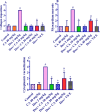Carnosic acid mitigates doxorubicin-induced cardiac toxicity: Evidence from animal and cell model investigations
- PMID: 38419896
- PMCID: PMC10897553
- DOI: 10.22038/IJBMS.2023.71508.15544
Carnosic acid mitigates doxorubicin-induced cardiac toxicity: Evidence from animal and cell model investigations
Abstract
Objectives: Utilization of doxorubicin (DOX) as a chemotherapy medication is limited due to its cardiotoxic effects. Carnosic acid exerts antioxidant, anti-inflammatory, besides cytoprotective effects. The objective of this study was to investigate the ability of carnosic acid to protect rat hearts and the MCF7 cell line against cardiotoxicity induced by DOX.
Materials and methods: The study involved the classification of male Wistar rats into seven groups: 1) Control 2) DOX (2 mg/kg, every 48h, IP, 12d), 3-5) Carnosic acid (10, 20, 40 mg/kg/day, IP, 16d)+ DOX, 6) Vitamin E (200 mg/kg, every 48h, IP, 16d)+ DOX 7) Carnosic acid (40 mg/kg/day, IP, 16d). Finally, cardiac histopathological alterations, ECG factors, carotid blood pressure, left ventricular function, heart-to-body weight ratio, oxidative (MDA, GSH), inflammatory (IL-1β, TNF-α), plus apoptosis (caspase 3, 8, 9, Bcl-2, Bax) markers were evaluated. DOX toxicity and carnosic acid ameliorative effect were evaluated on MCF7 cells using the MTT assay.
Results: DOX augmented the QRS duration, QA, RRI, STI, and heart-to-body weight ratio, and reduced HR, LVDP, Min dP/dt, Max dP/dt, blood pressure, boosted MDA, TNF-α, IL1-β, caspase 3,8,9, Bax/Bcl-2 ratio, decreased GSH content, caused fibrosis, necrosis, and cytoplasmic vacuolization in cardiac tissue but carnosic acid administration reduced the toxic effects of DOX. The cytotoxic effects of DOX were not affected by carnosic acid at concentrations of 5 and 10 μM.
Conclusion: Carnosic acid as an anti-inflammatory and antioxidant substance is effective in reducing DOX-induced damage by enhancing antioxidant defense and modifying inflammatory signal pathway activity and can be used as an adjunct in treating DOX cardiotoxicity.
Keywords: Anti-Inflammatory agents; Anti-oxidants; Cardiotoxicity; Electrocardiography; Salvin; Vitamin E.
Conflict of interest statement
The authors declare that they have no conflicts of interest.
Figures









Similar articles
-
In Vivo and In Vitro Protective Effects of Rosmarinic Acid against Doxorubicin-Induced Cardiotoxicity.Nutr Cancer. 2022;74(2):747-760. doi: 10.1080/01635581.2021.1931362. Epub 2021 Jun 4. Nutr Cancer. 2022. PMID: 34085575
-
Carnosic acid protects against doxorubicin-induced cardiotoxicity through enhancing the Nrf2/HO-1 pathway.Food Funct. 2023 Apr 24;14(8):3849-3862. doi: 10.1039/d2fo03904d. Food Funct. 2023. PMID: 37013966
-
Carvedilol (CAR) combined with carnosic acid (CAA) attenuates doxorubicin-induced cardiotoxicity by suppressing excessive oxidative stress, inflammation, apoptosis and autophagy.Biomed Pharmacother. 2019 Jan;109:71-83. doi: 10.1016/j.biopha.2018.07.037. Epub 2018 Nov 2. Biomed Pharmacother. 2019. PMID: 30396094
-
Protective effects of necrostatin-1 on doxorubicin-induced cardiotoxicity in rat heart.Hum Exp Toxicol. 2022 Jan-Dec;41:9603271211066066. doi: 10.1177/09603271211066066. Hum Exp Toxicol. 2022. PMID: 35137609
-
Effect of carnosic acid on acrylamide induced neurotoxicity: in vivo and in vitro experiments.Drug Chem Toxicol. 2022 Jul;45(4):1528-1535. doi: 10.1080/01480545.2020.1845715. Epub 2020 Nov 19. Drug Chem Toxicol. 2022. PMID: 33213219
Cited by
-
Effect of Crocus sativus L. (saffron) and Rosmarinus officinalis L. (rosemary) in hepatocellular carcinoma: A narrative review of current evidence and prospects.Iran J Basic Med Sci. 2025;28(8):986-1003. doi: 10.22038/ijbms.2025.84172.18204. Iran J Basic Med Sci. 2025. PMID: 40584445 Free PMC article. Review.
-
Assessing the efficacy of herbal supplements for managing obesity: A comprehensive review of global clinical trials.Iran J Basic Med Sci. 2025;28(6):691-709. doi: 10.22038/ijbms.2025.84150.18198. Iran J Basic Med Sci. 2025. PMID: 40343290 Free PMC article. Review.
-
Exploring the role of curcumin, nanocurcumin, and a PPAR agonist in preventing paraquat-induced systemic inflammation and oxidative stress in rats.Iran J Basic Med Sci. 2025;28(7):852-859. doi: 10.22038/ijbms.2025.82057.17753. Iran J Basic Med Sci. 2025. PMID: 40703756 Free PMC article.
-
Nutritional Advantages of Walnut (Juglans regia L.) for Cardiovascular Diseases: A Comprehensive Review.Food Sci Nutr. 2024 Dec 30;13(1):e4526. doi: 10.1002/fsn3.4526. eCollection 2025 Jan. Food Sci Nutr. 2024. PMID: 39803290 Free PMC article. Review.
-
Toxicity and safety of rosemary (Rosmarinus officinalis): a comprehensive review.Naunyn Schmiedebergs Arch Pharmacol. 2025 Jan;398(1):9-23. doi: 10.1007/s00210-024-03336-9. Epub 2024 Aug 3. Naunyn Schmiedebergs Arch Pharmacol. 2025. PMID: 39096378 Review.
References
-
- Eisvand F, Imenshahidi M, Ghasemzadeh Rahbardar M, Tabatabaei Yazdi SA, Rameshrad M, Razavi BM, et al. Cardioprotective effects of alpha-mangostin on doxorubicin-induced cardiotoxicity in rats. Phytother Res. 2022;36:506–524. - PubMed
-
- Rahbardar MG, Eisvand F, Rameshrad M, Razavi BM, Hosseinzadeh H. In vivo and in vitro protective effects of rosmarinic acid against doxorubicin-induced cardiotoxicity. Nutr Cancer. 2022;74:747–760. - PubMed
-
- Schimmel KJ, Richel DJ, van den Brink RB, Guchelaar H-J. Cardiotoxicity of cytotoxic drugs. Cancer Treat Rev. 2004;30:181–191. - PubMed
-
- Mantawy EM, El-Bakly WM, Esmat A, Badr AM, El-Demerdash E. Chrysin alleviates acute doxorubicin cardiotoxicity in rats via suppression of oxidative stress, inflammation and apoptosis. Eur J Pharmacol. 2014;728:107–118. - PubMed
LinkOut - more resources
Full Text Sources
Research Materials
